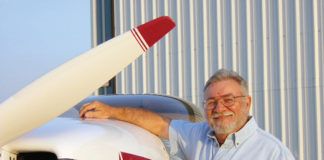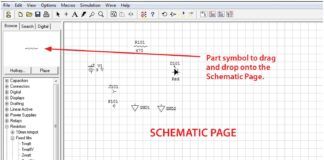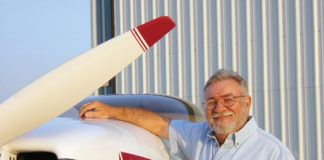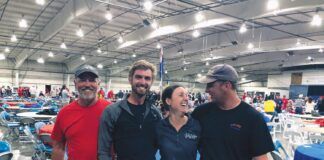For those of us who, like Snoopy, have entertained the daydream of going head to head with some worthy enemy aviator during wartime, behold the Staaken Flitzer as a way to further facilitate the fantasy. It is a remarkable airplane—the only biplane I know of that will not only fly, but fly really well behind the modest power of a VW engine. While the Flitzer is supposed to be a mythical inter-war sportplane, this thing’s an eagle in dove’s plumage.
Brainchild of British aviation artist and lifelong aeronautical enthusiast Lynn Williams, the Flitzer is a modern design with a distinctly period flavor, masquerading as a 1920s German sport biplane of Great War layout. Williams supplies plans for several sub-types of the basic design. The original Z-1 Flitzer was his bright red prototype, powered by an 1835cc VW. Next came the stronger Z-21, incorporating a longer-span horizontal stabilizer and other small refinements, but still using a 22-inch-wide fuselage. Larger pilots can build the later Z-21A featured in this article, with its enlarged 24-inch cockpit.
The slightly more compact Stummel Flitzer has a shorter fuselage with raked cabane, a larger tank bay and rounded flying surfaces. This model is available in two versions, the Types S and R, optimized for intermediate level aerobatics, using more powerful engines in the 60 to 110 horsepower range. The Stummel Flitzer’s structure is strengthened to cope with +6/-3 G loading, and balanced slaved ailerons have been added to its upper wings to improve roll performance.
More than 200 sets of Flitzer plans have been sold. They come as 33 comprehensively illustrated, 3×2-foot sheets, with much text and many perspectives, including exploded views of individual components. All metal fittings are drawn to full size, and the original plans have been updated to reduce fabrication time. Those sub versions are all derivatives, and they come as modifications to the basic plans.
Two Flitzers, No Waiting
I have sampled two of the half-dozen or more flying Flitzers. Englishman Rupert Wasey’s award-winning example (the natural wood-colored one in these photos) has an 80-hp AeroVee 2180cc VW conversion with a single magneto and electronic ignition with dual Hall effect coils, each firing two spark plugs. It also has a starter and an alternator charging an onboard battery, and drives a 60×34-inch Alan Newton beech wood propeller. Wasey’s plane significantly outperforms an 1800cc VW-powered Flitzer kept in the same hangar. The second Flitzer I flew was Australian design and technology teacher Mark Crawford’s. His has an Australian production four-cylinder Jabiru 2200 engine, also developing 80 hp at 3300 rpm, but driving an Australian Heliptera propeller. His blue fuselage mimics that of WW-I Lieutenant Jansen’s of Jasta 6.
Flitzers use conventional construction with plank spars and built-up ribs forming the USA 35B wing sections, squared off with laminated wood wingtip bows. All ribs are identical for ease of building, though the lower wing’s structure is a little more complex, and the upper wing has a slightly wider chord due to its thicker spar. The interplane struts are complex works of art, using spruce blocks, plywood cheeks and spruce fairings, which make them look like authentic single-piece components.
The short cabane struts are of welded steel tube, and the landing gear is also a steel tube structure: It’s a pair of triangular frames supporting two fixed cross-axles. These support a third, floating axle, held in place with tightly wound half-inch elastic bungee. There can be variation in the wheels. The plans call for re-spoked Honda C-90 moped wheels with new hubs and no brakes, but both the examples I flew had fat motorcycle tires and cable-operated heel brakes.
The Flitzer’s fuselage is the usual built-up wood box with scarfed ply exterior skins and fabric covering, and beautifully scarfed pressings of 1.0mm and 0.8mm ply for the rear decking and cable fairleads.
Looking Inside
The small instrument panels each hold eight miniature instruments plus a radio. Wasey’s is a Micro-Air, which fits into a standard 2.25-inch instrument hole, while Crawford uses a handheld. Wasey’s has a throttle and mixture quadrant on the left sidewall, fuel on/off selector on the right and a sprung carburetor heat knob in the center. Crawford’s layout is slightly different, with a single sidewall throttle (the Jabiru’s Bing carburetor has no mixture control) next to the choke. Both use cork-and-wire fuel gauges and are otherwise similar.
The Wasey Flitzer’s empty weight includes 5 pounds of lead ballast to compensate for its heavy engine; Crawford’s is built from denser fir. They both tip the scales at around 540 pounds. Adding 60 pounds of fuel and 180 pounds of the author took our total to 780 pounds—somewhat more than the 750-pound official maximum. The temperature was about 70° F for all of my flights, and generally with a 10-knot breeze slightly across the runway.
The Flitzer is small and short-coupled, with a tall, narrow-track landing gear, so building it with the original fixed tailskid would only be a good idea if all of your flying was to be off grass. Because of this, both owners have fitted theirs with differential foot brakes and a lockable swiveling tailwheel to improve ground handling on hard surfaces.
Looking Outside
Your eyes look straight along the forward fuselage past a small windshield and through a low triangular tunnel of cabane struts. The nose sticks up high ahead and pretty much in the way of a direct forward view, but it is quite narrow, so your weaves need only be 15° to 20° either side. The maingear is nicely sprung, and both airplanes’ brakes were exactly right, with no play and enough effect to turn precisely. For a tighter turn, you can ease the stick forward a little and give a blast of power without any tendency to lift the tail and stand the ironmongery on its nose.
When I opened the throttle on Wasey’s, that big VW emitted a most un-Volkswagen-like snarl, and the airplane surged forward with steady acceleration. Only a tiny bit of left rudder pressure was needed until I lifted the tail at around 30 mph. Then it gave a wayward dart to the right, easily and immediately caught by a dab of left rudder. At 45 mph in the tail-high attitude, it flew off cleanly with gentle back pressure on the stick. I accelerated to 60 mph in ground effect in the time-honored manner, after which we were soon climbing like an interceptor at an eager 700 fpm. By then you could no longer hear the enthusiastically blattering engine over the roar of slipstream in the wires.
Having a muffler as standard, Crawford’s Jabiru engine is much quieter, and it rotates the other way (like a Continental or Lycoming), so right rudder is required; otherwise, its handling was much the same. Its performance was perhaps a little less sprightly, but that was probably a propeller issue rather than an engine one.
Maximum level speed at full throttle for both airplanes was about 95 mph IAS, but setting 3000 rpm on the VW gave a comfortable 85-mph cruise, burning perhaps 4 gph for an effective safe endurance of 2 hours. Wasey usually cruises his at 75 mph at about 2750 rpm. Neither airplane is about raw speed.
Being a biplane, visibility in flight is inevitably less than brilliant forward past all those wings and wires, but it is more than adequate, especially behind the trailing edges. Both windshields were a little small for me; I could feel the wind biting between my goggles and the helmet’s rim. Nevertheless, it was great to wheel and turn over the countryside, framing golden villages and green fields between those silver wings.
Swing It Around, Then
Turns each way need just a little squeeze of rudder to coordinate; overdo it with a bigger, Tiger Moth-sized push, and the nose will slew across the sky. As expected, Flitzers have low aileron forces, with instant response and a high roll rate. The ailerons are very powerful and the elevator is light, but with plenty of feel. Indeed, all of the controls are light and, yes, nicely harmonized, something writers often claim without it really being true. Believe me, this airplane has classically harmonized controls, with light ailerons, slightly heavier elevators, and a rudder that is just slightly heavier or firmer in feel—perfect!
I made tight turns left and right with the cabane struts parallel to and just above the horizon. This gave a neat and easily judged 60° or so of bank, and I was satisfyingly able to hit my own slipstream after just two rotations. A properly coordinated wing-waggle was a bit harder, because at first I used too much rudder. A squeeze is all you need.
Nevertheless, the slow handling is fine. Throttled back, speed reduces more gradually than the low inertia and apparent
high drag led me to expect. However hard you raise the nose, a Flitzer won’t really stall, but just mushes downward at 41 to 45 mph (depending on airplane, weight and configuration). With no elevator trim, 8 to 10 pounds of stick back pressure are needed to achieve a stall.
Even with some power on, these airplanes just nod their noses, with no warning buffet, but no wing drop either. But they do sink power-off. Doing just a couple of stalls lost me a full 500 feet!
Williams told me that the Z-21 is significantly stronger than the prototype Z-1, which was designed to the old British Semi-Aerobatic category of +3.8 G with a reserve and +4.4 G ultimate. All reserve factors on the Z-21 were subsequently increased for those components with less than a 1.5 reserve. This makes Z-21 Flitzers fully aerobatic, with a maneuvering speed of 100 mph and a 120-mph Vne. Nevertheless, Williams recommends against flying snap maneuvers, sustained inverted flight or outside maneuvers.
Tilt-a-World
First I tried a few wingovers, each way, in both airplanes. These were easy and tremendous fun, so I went further, flying gentle aerobatics from 3000 to 2000 feet with a maximum of 2.5 G. Wasey had warned me that his could flick if you pulled too hard over the top of a loop, which surprised me, considering the Flitzer’s light weight and low wing loading, but I didn’t encounter this problem with either airplane.
You need some rudder each way in the loop but not much. I started my first at 110 mph and saw 40 on the dial over the top. All my loops probably weren’t properly circular, but they were tight, and it was satisfying to look up over the center section to admire the inverted world above while floating across the top.
Barrel rolling to the left at 100 mph was a bit difficult because of interference between the stick, my knee and the throttle. It was easier rolling to the right, but either way you do have to raise the nose very high before applying aileron or else it falls a long way during the maneuver, even if you roll with full aileron. Wasey said he got a face full of fuel when he tried a slow roll. Neither airplane’s fuel cap had been modified for aerobatics, so I decided not to bother.
Hammerheads took increasing rudder on the way up (left with the VW, right with the Jabiru). Holding each airplane in the vertical for just a moment (as anticipated, they slow quickly), I hit the appropriate rudder at 40 mph and round they both went, pirouetting right on the spot, sweet as a chocolate-coated nut, and with little need for either forward elevator or opposite aileron. Throttling back halfway around kept the radius tight and gave me plenty of time to accelerate in the downward vertical before pulling out.
Back in the pattern, I flew downwind with 2500 rpm and 65 mph, and then throttled back to 2000 rpm for the approach at 60. Wasey said not to fully close the throttle because the plane sinks rather rapidly in this configuration, though when I was more used to the type, I did try several glide approaches. Some stick back pressure is needed at this speed, but there is still plenty of control authority for countering gusts.
A curving approach is best for decent forward visibility, and to keep the threshold in sight. With the nose well down to hold 70 mph, I found I actually got the best view of the runway by stretching my neck to look over the top wing. There is plenty of elevator effectiveness, with or without power, and on one occasion when the Jabiru stopped on final, I found there was still enough elevator control for a proper flare. Despite a fairly prolonged hold-off, these little airplanes don’t float far, thanks to that vast amount of drag, especially with the nose raised and the undersurfaces of all four wings presented to the airflow.
Now You Can Land It
You have to rotate the nose through a big angle to get it up to the correct three-point attitude, and this takes time. However, if you are not patient, and your stick is not fully against the backstop by the time the wheels brush the turf, the airplane will bounce on its stiff maingear legs. Trying to correct this by pumping the stick back and forth merely causes pilot-induced oscillations and divergent bounces. The only solution is to open the throttle and go around.
Crawford’s Jabiru Flitzer was better in this regard; its slightly softer bungees have a little more give and generally allowed a softer, bounce-free landing despite my repeated inability to get the stick all the way back to its rear stop.
When you do get the flare right, and everything comes together nicely, it can be truly rewarding. For a proper three-pointer, you hold the stick right back into your gut at touchdown, and then ride out the little bounces and waddles as you gradually lose momentum, dancing your feet lightly on those rudder pedals (and, occasionally, the brakes) to keep straight.
Nearly every time both airplanes slowed, and despite their engines rotating in opposite directions, they both showed a distinct attraction toward the trees along the right runway margin. Sometimes an early rudder input would stop this before it got started, but on other occasions a good jab of left brake was needed as well. I did not fly either off a hard-surface runway, but I suspect that would be more challenging.
Nevertheless, and partly because of their ground manners, Flitzers are the kind of airplane you would never tire of—endlessly challenging to fly accurately, but immensely satisfying when you get things just right. Nimble, maneuverable and sprightly, their handling is perfect for the connoisseur. Above all, they’re just so much fun!
For more information, contact Lynn Williams by emailing [email protected]. For the North American dealer and parts kits information, call 780/417-2008, or visit http://www.flitzer-aero.com/ or www.flitzerbiplane.com.
Find info about Rupert Wasey at http://www.wasey.aeroplanes.com/ and Mark Crawford at http://members.iinet.net.au/~hawk1




